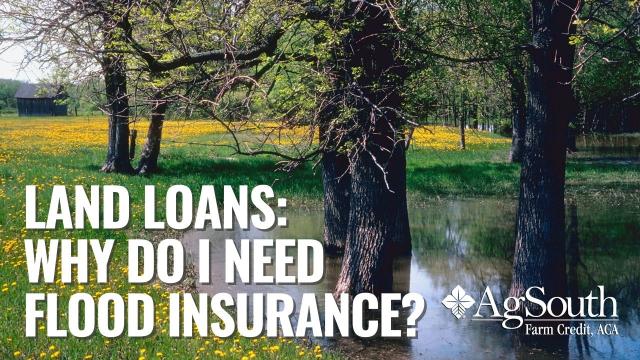Land Loans: Why Do I Need Flood Insurance?

Who determines if you need flood insurance and what kind of structures are required to be covered? We discuss this and more.
Key takeways:
- Land purchases with structures on it may be subject to obtaining flood insurance.
- Any structure determined to be in a flood zone with two or more rigid exterior walls in place that is principally above ground and affixed to a permanent site must have insurance - even inhabitable ones.
- If flood insurance is necessary, the borrower is required to obtain it before the loan can be closed.
Flood insurance is not something most folks think they’re going to deal with, but it comes up during the land loan process more often than you might think. So what’s the deal with it? We’re here to help explain.
The National Flood Insurance Program
The National Flood Insurance Program (NFIP) was first created through the National Flood Insurance Act of 1968. The program is administered by the Federal Emergency Management Agency (FEMA) and aims at reducing the impact of flooding on both public and private structures.
Understanding Flood Insurance
Most people know that a home located in a flood zone will be required to have flood insurance. They understand that purchasing it will protect them from significant costs due to flooding. But what you might not know is that when you are purchasing real estate of any kind that has a structure on it, your lender is required by the Federal Government, through NFIP, to perform a “flood determination.” So there’s no avoiding this step!
What kind of “structures” does that mean? Any structure with two or more rigid exterior walls in place that is principally above ground and affixed to a permanent site (house, barn, grain bin, poultry house, etc., and even an UNLIVABLE DWELLING) is subject to a flood determinaton. That includes that fallen down house on the back corner of the property that no one has set foot in for 50 years.
Unfortunately, the value of the property is not what determines what structures must have a flood determination. This is FEMA regulated and required by law, and all banks are obligated to require the flood determination on structures located on any size real estate.
Making the Flood Determination
Your lender will send your property information to FEMA to evaluate your property. He or she will look at the FEMA flood maps and other property-specific information. Once evaluated, they will send back the determination to your lender:
NO – You do not need flood insurance and the loan process continues
YES – You must obtain flood insurance
What Happens Next?
If it’s a yes, then one of three things comes next.
- If a structure on the property is in a flood zone, your lender will require you to have enough insurance to cover the value of the structure.
- If the loan amount is LESS than the value of the structure, your lender will require you to have enough insurance to cover the loan amount.
- If the value of the structure is $0, your lender will require you to have the minimum amount of flood insurance offered.
Here are Some Scenarios
Scenario 1: Say you purchase a 100-acre tract. FEMA determines that only part of the property is in a flood zone and that the structure located on the property is on the portion of the property that is not a flood zone. In this scenario, flood insurance would not be required.
Scenario 2: Say you purchase some property with a home and the total purchase price is $500,000. The entire property and home are in a flood zone, and insurance is required. The value of the home is $200,000. You will only be required to have $200,000 in flood insurance – the value of the home only.
Scenario 3: You purchase a piece of property valued at $500,000. There is a home, worth $200,000, on the tract that is in a flood zone and requires insurance. However, you are only financing $150,000 of the value of the home. You will only be required to have $150,000 in flood insurance – the value of the loan only. BUT we recommend that you purchase adequate insurance to cover the value of your home regardless of the requirement. Protecting yourself in the case of serious flood damage is worth the insurance investment.
Scenario 4: You purchase a piece of property with a 100-year-old unlivable 2-room house that is in a flood zone. The appraisal values the house at $0. Flood insurance is still required, but you only have to have the lowest possible amount of flood insurance that an insurance company will write.
Purchasing Flood Insurance
Understanding this process and some situations you may encounter will hopefully make you feel more informed and avoid surprises! Interested in purchasing flood insurance for your home? Visit floodsmart.gov.
Have more questions about flood insurance and the land loan process? Contact us!